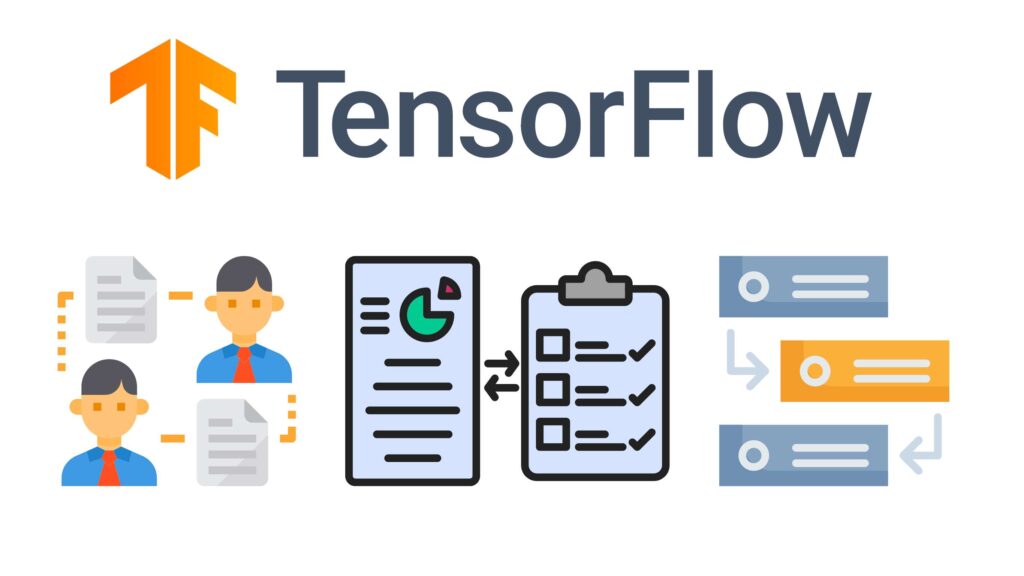Table of Contents
What Is TensorFlow?
TensorFlow is an open-source software library for dataflow and differentiable programming across a range of tasks.
It is a symbolic math library and is used for machine learning applications such as neural networks.
It was developed by the Google Brain team and is used in many of Google’s products and services.
TensorFlow provides a high-level API for building and training machine learning models, as well as low-level APIs for customizing the model architecture and fine-tuning it for specific use cases. With its flexible architecture, TensorFlow can run on a single device, on-premise, in the cloud, or on mobile devices.
what is tensorflow used for?
TensorFlow is a powerful open-source software library that is used for a variety of tasks in the field of machine learning, including:
- Neural Network Design: TensorFlow provides a high-level API for designing and training neural networks for a variety of tasks such as image classification, natural language processing, and predictive analytics.
- Deep Learning: TensorFlow is widely used for deep learning, a subfield of machine learning that uses neural networks with multiple layers to model complex relationships in data.
- Computer Vision: TensorFlow can be used for tasks such as object detection, image segmentation, and image recognition.
- Natural Language Processing: TensorFlow can be used for tasks such as sentiment analysis, language translation, and text generation.
- Predictive Analytics: TensorFlow can be used to build predictive models for tasks such as stock price forecasting, recommendation systems, and fraud detection.
- Reinforcement Learning: TensorFlow can be used to develop reinforcement learning algorithms, a type of machine learning where an agent learns to perform actions in an environment to maximize a reward signal.
- These are just a few examples of the many use cases for TensorFlow. With its flexible architecture and a large community of contributors, TensorFlow is a popular choice for machine learning and deep learning applications.
Pros and cons of TensorFlow:
- Open-source, flexible, and high performance.
- Can run on multiple platforms, including GPUs and TPUs.
- Has a large community of contributors and users.
- Complex library with a steep learning curve.
- Debugging machine learning models can be difficult.
- Can be slow for certain models or tasks and have a large memory footprint.
TensorFlow supported operating systems
TensorFlow supports a variety of operating systems, including:
Windows: TensorFlow can be installed and run on Windows systems, including both desktop and server versions.
Linux: TensorFlow is primarily developed and tested on Linux systems and has good support for this platform.
macOS: TensorFlow can also be installed and run on macOS systems.
Cloud Platforms: TensorFlow can be run on cloud platforms such as Google Cloud, Amazon Web Services (AWS), and Microsoft Azure.
TensorFlow can also run on a variety of hardware, including CPUs, GPUs, and TPUs, and can be used in both standalone and distributed environments. This makes TensorFlow a highly portable and scalable tool for developing machine learning models.
TensorFlow important features

TensorFlow has several important features, including:
- Automatic Differentiation
- Distributed Training:
- High-level API
- Visualization:
- Large Community:
- Production-
- Portable:
Automatic Differentiation: TensorFlow allows for the automatic differentiation of mathematical expressions, which is a crucial feature for training machine learning models.
Distributed Training: TensorFlow supports distributed training, which allows machine learning models to be trained across multiple devices, such as GPUs or TPUs.
High-level API: TensorFlow provides a high-level API that makes it easy to build and train machine learning models, while also providing low-level APIs for more custom and advanced use cases.
Visualization: TensorFlow includes a suite of tools for visualizing and debugging machine learning models, including TensorBoard.
Large Community: TensorFlow has a large community of contributors and users, which means that there is a wealth of resources, tutorials, and tools available for getting started with the library.
Production-Ready: TensorFlow has been designed for production deployment and can be used for a wide range of machine learning tasks, including image recognition, natural language processing, and recommendation systems.
Portable: TensorFlow can run on a single device, on-premise, in the cloud, or on mobile devices, making it a good choice for developing machine learning models that can be deployed in a variety of environments.
How to install tensorflow in Windows and Mac

Here are the steps to install TensorFlow on Windows and Mac:
Windows: a. Install Python: TensorFlow requires Python, so you need to install Python on your Windows system first. You can download and install the latest version of Python from the official Python website. b. Install TensorFlow: Once you have installed Python, you can install TensorFlow using the pip package manager. Open the command prompt and run the following command:
pip install tensorflowMac: a. Install Python: TensorFlow requires Python, so you need to install Python on your Mac system first. You can download and install the latest version of Python from the official Python website. b. Install TensorFlow: Once you have installed Python, you can install TensorFlow using the pip package manager. Open the terminal and run the following command:
pip install tensorflow
Note that the exact installation process may vary depending on your operating system and the version of TensorFlow that you want to install. You can find more detailed instructions on the TensorFlow website.
Tensorflow User experience
TensorFlow, as a deep learning framework, is designed to be used by developers, researchers, and data scientists. The user experience of TensorFlow can vary depending on the level of experience and expertise of the user.
For beginners, TensorFlow can have a steep learning curve, especially if they have little to no prior experience with deep learning or programming. TensorFlow’s architecture is highly flexible and powerful, but this can also make it complex to understand and use for those who are just starting out.
For experienced users, TensorFlow provides a rich and flexible ecosystem, including extensive documentation and tutorials, a large community of users, and a wide range of pre-trained models and tools. The flexibility of TensorFlow’s architecture allows for the development of complex deep learning models and solutions, and the ability to scale for large-scale deployment.
Overall, TensorFlow offers a wide range of features and capabilities for deep learning, but the user experience can be challenging for beginners and those who are new to deep learning. However, with time and effort, TensorFlow can be a powerful tool for developing and deploying machine learning models.

🌟 Unleash the Digital Power with Devendra Gupta 🌟
🖥️ Tech Enthusiast |Software Reviewer| Blogging Expert | SEO Guru |
Web developer 📊
🔍I tested hundreds of Software and reviewed


